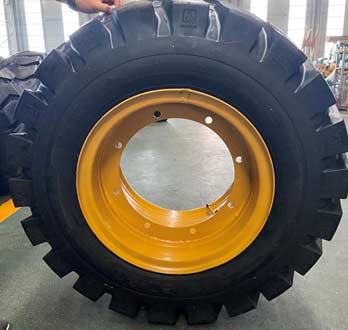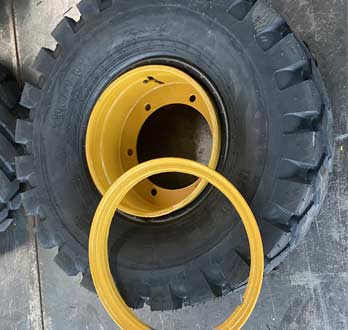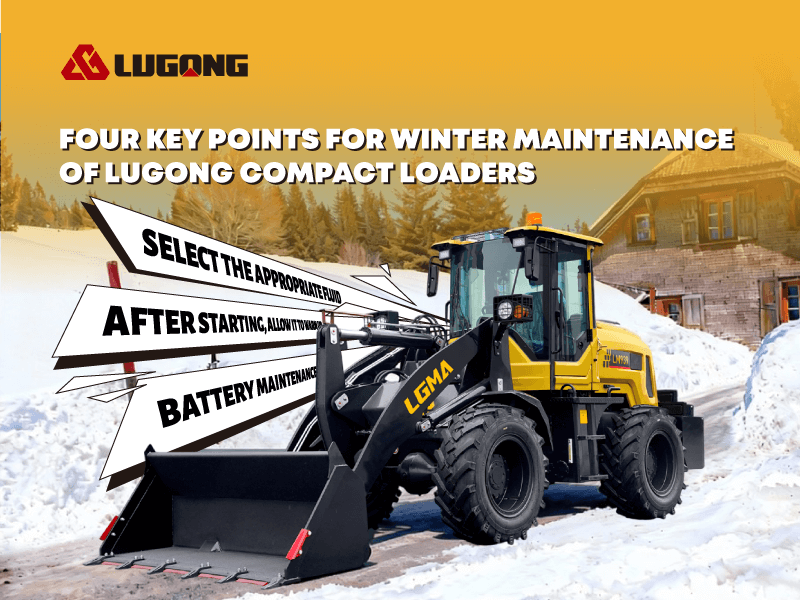How to Choose Wheel Loader Tires
Tires are annular elastic rubber products that roll on the ground and are assembled on various vehicles or machinery. Usually installed on the metal rim, it can support the body, buffer the external impact, realize the contact with the road surface and ensure the driving performance of the vehicle. Tires are often used under complex and harsh conditions. They are subjected to various deformations, loads, forces, and high and low temperature effects during driving. Therefore, they must have high bearing performance, traction performance, and cushioning performance. At the same time, high wear and flex resistance, as well as low rolling resistance and heat build-up are also required. The correct tread design, tread depth and load capacity are key to identifying the right tire to maximize loader performance.
Classification by tire structure

Radial tires
The angle formed between the carcass cord and the steel belt cord is like the earth’s meridian, so it is called a radial tire, as the name suggests. Radial tires tend to be more expensive. However, the total cost of ownership of the machine is likely to be lower because the tires provide better traction and buoyancy and help reduce fuel consumption. Radial tires have better control, especially at high speeds, because the tires don’t flex as much, and the rolling resistance allows wheel loader operators to corner more easily.
Radial tires usually consist of two parts. The first is the shell, which consists of a layer of rubber-coated steel cords that run from bead to bead. The second is a layer of rubber-coated steel — made up of steel strips — placed under the tread to help prevent cuts and punctures.
Radial tires are ideal for applications where traction, tread wear and distance are important factors. Many times, wheel loader tires run on the surface of the loading application. Operators looking for tires that perform well on gravel and in applications where sidewalls may be cut should consider bias tires, as the sidewalls are thicker.
Bias tire
Bias tire carcass cord layers and layers are arranged in a cross, so it is called a bias tire. Pneumatic tires in which the cords of the adjacent layers of the ply and the buffer layer are arranged at a certain angle to the centerline of the tire are called ordinary bias tires. Ordinary bias tire structure: the tire consists of a crown, a ply, a buffer layer and a bead. The ply is the skeleton of the outer tire, used to maintain the shape and size of the outer tire. The intersection angle (crown angle) between the cord of the cord and the meridian section of the tire is generally 48 degrees to 55 degrees, and the cords of adjacent layers are arranged to intersect. The higher the number of plies, the greater the strength, but the lower the elasticity. The number of plies is marked on the surface of the tire, such as 16 layers, 18 layers.
Radial tires are ideal for applications where traction, tread wear and distance are important factors. Many times, wheel loader tires run on the surface of the loading application. Operators looking for tires that perform well on gravel and in applications where sidewalls may be cut should consider bias tires, as the sidewalls are thicker.
Various tread patterns
After determining the best tire type for the application, the next step is to choose a tread pattern or tire design. Correct tread design, tread depth and load capacity are the keys to identifying the right tire to maximize loader performance
Longitudinal pattern
Advantages: This pattern has excellent handling stability, low rotational resistance, and is not easy to laterally slip.
Disadvantages: The braking performance is relatively weak, the driving force is not as good as other tires, and it is not suitable for roads with poor conditions such as sand roads.
horizontal pattern
Advantages: The pattern is horizontally designed, and the contact area with the ground is large
Enhanced braking and driving force. Suitable for wilderness, construction
Bad road conditions such as construction sites.
Disadvantages: poor drainage and poor heat dissipation. While increasing the ground contact area, it also increases the noise. Reduced vehicle handling flexibility.
Longitudinal and horizontal pattern
Advantages: It absorbs the advantages of good drainage performance and low noise of the longitudinal pattern, and at the same time takes into account the strengths of the dynamic performance of the transverse pattern. The pattern type with both vertical and horizontal patterns has become the mainstream of the tire pattern.
Disadvantage: Abnormal wear and tear will occur.
Mud and snow patterns
Advantages: Its tire patterns are arranged in blocks, and this block pattern has the best driving force and braking performance among the four pattern types.
Disadvantages: The cost of construction is high, and it is generally not used for special road conditions.
Off-road pattern
Advantages: Off-road pattern is a pattern specially designed to adapt to dry, wet, rugged mountain roads and muddy and sandy roads.
Disadvantages: Due to the large contact pressure and rolling resistance of the pattern, it is not suitable for long-term driving on good hard roads.
How to Maximize tire life
To maximize the life of your wheel loader tires, you must first understand that each website is unique and that some applications may tax tires more than others.
A typical tire can last between 2,000 and 3,500 hours, but it all depends on the application, and you must consider the applications in which the operator will use the machine to determine if your tire has a useful life.
For example, tires used in rock or quarry applications may have a shorter service life than tires used in sand, dirt or concrete applications. How the operator operates the machine also has an impact on the life of the tires. For example, an operator who packs tires in a pile may create more tire cuts and also cause tires to wear out faster.
Operators should perform routine maintenance checks, including monitoring air pressure, to maximize tire life. There may be more pressure on the outside of the tires, causing problems later, and owners must also make sure their tires aren’t overinflated. If the tires are under- or over-inflated, it can cause the wheel loader to burn more fuel, which is less efficient.
Lugong wheel loader tires
In order to ensure the smooth and safe driving of wheel loader tires, Lugong strictly requires the quality of tires. Different types of loaders are equipped with different types of tires, so choose the appropriate tire type according to your actual needs.


1. Wear-resistant, tubeless tires are more wear-resistant than ordinary pneumatic tires, have better dynamic balance performance, and improve driving comfort, so they are more suitable for long-distance high-speed driving.
2. The weight is reduced and the fuel consumption is reduced. Due to the reduction of the inner tube and the cushion belt, the weight of the tire is reduced, and the spare parts of the rim are also reduced by the lock ring, which further reduces the weight. The whole set of tires can be replaced by tubeless tires, which can be several hundred kilograms lighter, and the running resistance of the tubeless tire is small. , which can save 3% of fuel, and the reduction of driving weight and fuel consumption is an additional profit for truck drivers.
3. The air leakage is slow, the air leakage is slow after the tubeless tire is punctured, and it can still be driven to the repair point for repair. After the inner tube of the ordinary tire is punctured by a foreign body, the air is quickly filled between the inner tube and the outer tire, and a flat tire will occur immediately. There may even be a puncture in an instant.
4. Good heat dissipation and long service life. The tubeless tire has no inner tube and pad, which effectively reduces the friction and heat generation between the inner tube of the tire and the inner cavity of the tire. The air inside is in direct contact with the rim, and the heat can also be directly dissipated through the rim, so that the tire temperature will not be too high. It can reduce punctures and prolong tire life.
Tips from Lu Gong: In order to prolong the service life of tires, try to reduce excess weight as much as possible, and pay attention to chronicity when driving on roads with poor road conditions. For more information on wheel loader tires, please contact us.

